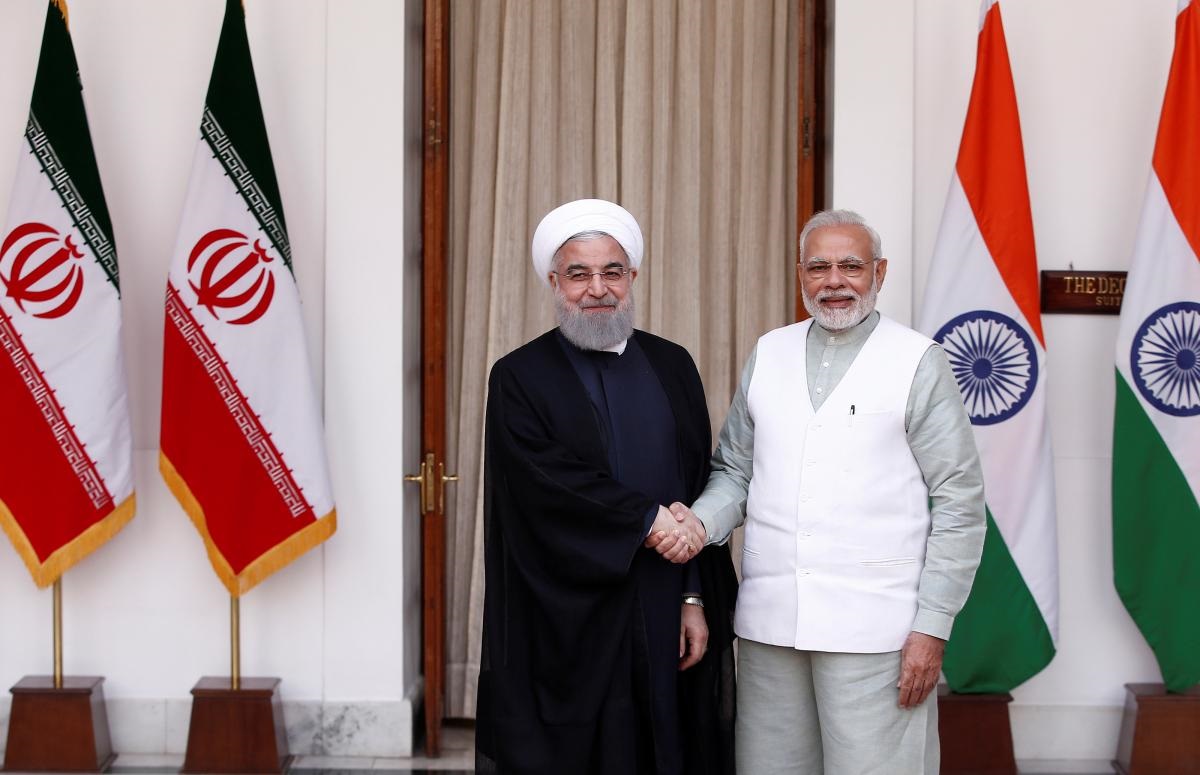Iran and India have signed several agreements, including a lease of the Iranian port of Chabahar, during Iranian President Hassan Rouhani's trip to India, from February 15-17.
During what was his first visit to India, Rouhani met with Indian Prime Minister Narendra Modi, and focused on boosting cooperation in the areas of defense and security, trade, investment and energy. The two sides signed nine memorandums of understanding (MoUs) in the areas of trade, agriculture, medicine, connectivity and taxation, according to India’s external affairs ministry.
The MoU regarding the Chabahar Port allows India to run operations in the first phase of the Chabahar port project for the next 18 months. According to the deal, the commitment of India and Iran is to develop multi-nodal connectivity.
Chabahar is located about 90 km (56 mi) from Pakistan's Gwadar port, which is expected to create competition within the Indian Ocean. Gwadar, in Pakistan's Balochistan province, is being developed by China as part of the mega-transportation project known as the Belt and Road Initiative.
Chabahar will allow Indian goods to reach Afghanistan via the Iranian port without having to cross Pakistan’s territory, as tense relations between Islamabad and New Delhi do not allow India to transport goods through Pakistan to Afghanistan and other Central Asian countries.
The port is also expected to become a key point along the 7,200 km (4,474 mi) International North–South Transport Corridor (INSTC) – a network of ship, road and rail routes that will move cargo between India, Afghanistan, the Caspian and Central Asia regions, and Europe.
In May of 2016, India, Iran and Afghanistan signed a contract to jointly set up a trade route for land-locked Central Asian countries. India committed around $500 million for the development of Chabahar Port and associated roads and railway lines as part of the deal, which also included plans to construct a railway line from Chabahar to Zahedan, located near the Afghan border.
India has so far invested $85 million in upgrading the first phase of the port from 2.5 million tons to 8.5 million tons. In November 2017, India sent shipments of wheat to Afghanistan through Chabahar Port, successfully bypassing Pakistan.
Bilateral trade between Iran and India reached $12.89 bn from 2016-17. India imported $10.5 billion worth of goods, mainly crude oil, and exported commodities worth $2.4 billion.
India is the second largest buyer of Iranian crude oil after China. Last year India cut Iranian crude oil imports, however, by about a quarter to 18.5 million tons to put pressure on Tehran to quickly wrap up negotiations on the development of the Farzad-B gas field.
India and Iran were initially targeting concluding a deal on the field development by November 2016, but later the two sides agreed to push the timeline back to February 2017, and subsequently to September 2017. However with deal stuck over the pricing of gas, no new deadlines have been proposed.
Iran was initially unhappy with the $10 billion plan submitted by India’s ONGC Videsh Ltd (OVL) for development of the 12.5 trillion cubic feet reserves in Farzad-B field and an accompanying plant to liquefy the gas for transportation in ships.
The total reserves of Iran’s offshore Farzad-B gas field, which was discovered by the OVL-led consortium in the Farsi block in 2008, is around 21.7 trillion cubic feet. With negotiations stuck over gas pricing, OVL offered to invest $6.2 billion to develop the gas field while leaving the marketing aspects to Tehran. According to OVL, the upstream part is to cost $ 6.2 billion while another USD 5 billion will be required to build a liquefied natural gas (LNG) export facility.
Rouhani’s visit to India was not all about energy, however.
The two countries also “agreed to hold dialogue to look into measures for cooperation in defence sphere, including port calls by naval ships, training and regular exchanges of defence delegations.”
“Iran and India also share concerns, including terrorism, as both are members of The Non-Aligned Movement (NAM),” the Iranian president said, according to IRNA.
Ensuring security and stability in Afghanistan poses a challenge to both India and Iran. Both countries desire peace in Afghanistan, but their approaches are markedly different. India views the presence of American troops as beneficial. Meanwhile, Iran wants the U.S.’s troops to leave Afghanistan as soon as possible.







 President Ilham Aliyev shed light on the evolving contours of the peace process with Armenia during an international conference in Baku this week. ...
President Ilham Aliyev shed light on the evolving contours of the peace process with Armenia during an international conference in Baku this week. ...
 Azerbaijan and Armenia started the process of demarcation of their border on Tuesday, with the installation of the first border markers based on ge...
Azerbaijan and Armenia started the process of demarcation of their border on Tuesday, with the installation of the first border markers based on ge...
 Armenian sappers commenced on Monday mine-clearance operations in the territories adjacent to the Saint Mary Church in village of Voskepar (Armenia...
Armenian sappers commenced on Monday mine-clearance operations in the territories adjacent to the Saint Mary Church in village of Voskepar (Armenia...
 As the conflict between Ukraine and Russia escalates, the strategic importance of Kharkiv, Ukraine's second-largest city, has come sharply into focus.
As the conflict between Ukraine and Russia escalates, the strategic importance of Kharkiv, Ukraine's second-largest city, has come sharply into focus.
 President Aliyev emphasized the critical role of the North-South Transport Corridor in fostering transport cooperation between Azerbaijan and Russi...
President Aliyev emphasized the critical role of the North-South Transport Corridor in fostering transport cooperation between Azerbaijan and Russi...



